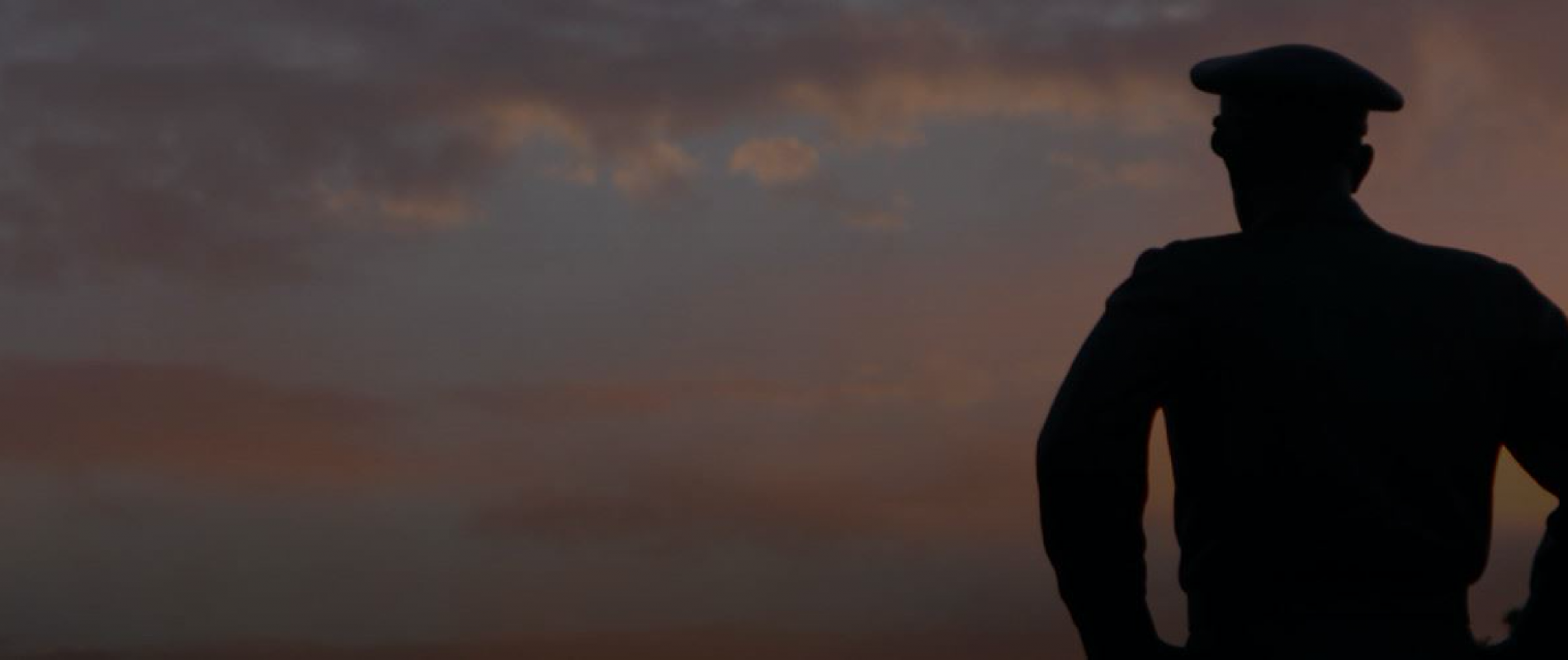
at his desk, 1944.
". . . Humility must always be the portion of any man who receives acclaim earned in blood of his followers and sacrifices of his friends. Conceivably a commander may have been professionally superior. He may have given everything of his heart and mind to meet the spiritual and physical needs of his comrades. He may have written a chapter that will glow forever in the pages of military history. Still, even such a man -- if he existed -- would sadly face the facts that his honors cannot hide in his memories the crosses marking the resting places of the dead. They cannot soothe the anguish of the widow or the orphan whose husband or father will not return."
- DDE, Guildhall Address, June 12, 1945
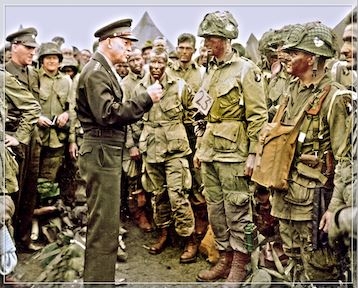
of the 101st Airborne Division
just before they board their planes to participate
in the first assault of the Normandy invasion.
For the new Supreme Allied Commander, the last two years of the war would be his most challenging yet. Eisenhower would oversee the gargantuan plan for the invasion of Europe: the largest air, sea, and land assault in history. He would be the one to give the ultimate order that he knew would send thousands of young men to their deaths. And, despite a top-notch staff and talented commanders, it would be he alone who would have to shoulder the crushing responsibility of decision making.
On January 2, 1944, Ike arrived in Washington, D.C. General Marshal had ordered him to rest before beginning the planning for Operation Overlord. The trip was hardly relaxing. Ike met with General Marshall and President Roosevelt. He and Mamie paid a hurried visit to John at West Point and then spent a few days alone together. He even managed to make a quick trip home to Kansas. But, when he arrived in London two weeks later, it was a great relief. Finally, he could get to work!\
Ike threw himself and his staff into planning the Allied invasion of France. Hitler had had four years to fortify the French coast, and predictions of Allied casualties were high. But Ike and his commanders grew steadily more confident that spring. Allied bombing was having an impact in the West and the Red Army steadily gained ground in the East.
As D-Day approached, Ike was bone weary and under extreme stress. It showed. He suffered from headaches, high blood pressure, insomnia, and ringing in his ears. Consequently, he often felt irritable and anxious and was tired much of the time. Even so, he had no choice but to push on.
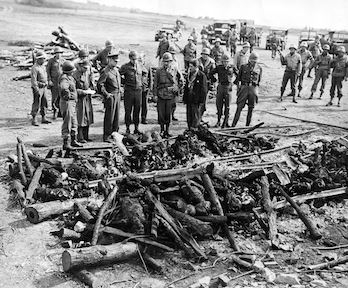
bodies of prisoners at Ohrdruf concentration camp.
Eisenhower immediately ordered the documentation
of what was found in order to have
first-hand evidence of what the Nazis had
done and make them accountable.
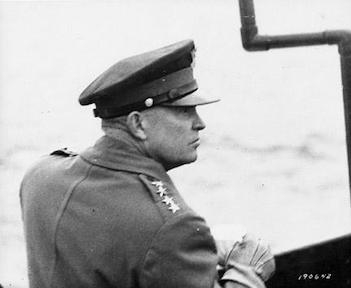
of a warship in the English Channel off the French coast.
On June 1, Ike moved his command post from London to Portsmouth, where he lived in a tiny trailer that he christened “my circus wagon.” It was here that he gave the go-ahead for a June 5 landing which was called back due to bad weather. Ike’s meteorologist forecast a brief window of clear weather for June 6. Sensing that it was now or never, in the early morning of June 5, Ike gave the order, “OK, let’s go.”
Ike tried to relax. He played checkers, met with a reporter, and wrote a message taking full responsibility in case Overlord should fail. He also visited with paratroopers of the 101st Airborne Division as they were preparing to board C-47s. Returning to his trailer — unable to sleep — he smoked, drank black coffee, and read westerns. He had launched the mightiest military campaign known to mankind; nothing could stop it now.
By late evening, June 6, it was clear that Overlord had succeeded. The Allies had put more than 150,000 men ashore, and the beachheads were littered with Allied tanks and artillery. In late July the Allies would finally achieve a “breakout” in Normandy and, by August 25, Paris would be liberated. The Allies advanced eastward through the autumn of 1944. But hopes to end the war before Christmas were dashed when bad weather set in. And, on December 16, as Ike was promoted to the new five-star rank of General of the Army, the Germans launched a final attack: the Battle of the Bulge.
The Allied offensive would pick up again in early spring 1945. In mid-April, Ike inspected a concentration camp near Gotha, Germany. He was visibly shaken by the horrors he witnessed there. Immediately, he summoned reporters and congressional representatives from the United States; he believed firmly that history must have an accurate and permanent record of these unspeakable atrocities.
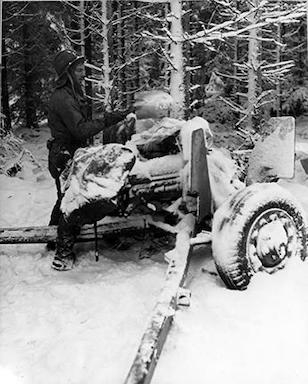
Sgt. William Showers of Benezett, Pennsylvania,
cleans the snow from the breech of his
57mm anti-tank gun in the woods near Courtil, Belgium.
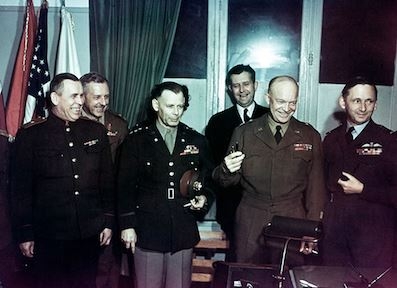
By early March, the collapse of the Third Reich was imminent. Just before 3:00 a.m., on May 7, 1945, a weary Eisenhower accepted the German unconditional surrender. Someone on Ike’s staff opened a bottle of champagne in a half-hearted attempt to celebrate but it was flat. Exhausted, everyone went to bed.
The first months after the German surrender were incredibly busy for Ike. Unending paperwork, a flood of congratulations, and mountains of correspondence threatened to bury him. Invitations arrived daily, but he could accept only a few, among them victory celebrations in London, Washington, New York, and his beloved hometown of Abilene.
Upon returning to Europe, one of Ike’s most pressing problems was to find a way to feed 5.5 million hungry people. Of particular concern was the plight of displaced persons, especially the Jews. There was little food and clothing, and refugee camps were filthy and crowded. In August 1945, General Marshall was stepping down as Chief of Staff and President Truman wanted Eisenhower for the job. Ike was not enthusiastic, but agreed to serve for two years. He was now 55 years old and had done his duty for 35 years; what he really wanted most was a long rest.
The Eisenhower Family
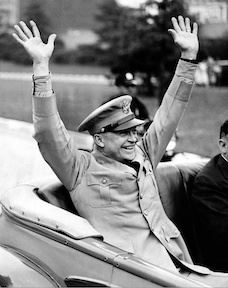
from New Yorkers in 1945.
Mamie was still living in Washington and John was finishing the semester at West Point when Ike had been named commander of Overlord in December 1943. On orders from General Marshall, Ike made a secret trip home to see his family. John felt that his father was much the same except that he was preoccupied. Ike and Mamie spent a few quiet days together, but the adjustment from wartime to family life was awkward for both of them. Ike traveled to Manhattan, Kansas, for a one-day Eisenhower reunion but found it impossible to relax. Overlord and what lay ahead weighed heavily on him.
To ease her loneliness after Ike left, Mamie joined her parents in San Antonio for the rest of the winter. It was a painful time for her as she tried to adjust to losing her husband yet again. She knew that she was in the public eye, so Mamie did her best to deal with her unhappiness privately.
At breakfast on his graduation day, June 6, 1944, John learned that the invasion of Europe was in progress. Mamie was awakened by a phone call from a reporter asking her about the Normandy landings. For security reasons, she had been told nothing. All day long, John and Mamie were the focus of reporters and flashing cameras.

day of John's graduation from
West Point: June 6, 1944.
Following graduation, John visited his father for three weeks. He enjoyed a front row seat to history in the making. On June 15, John traveled with his father to Normandy. Soldiers recognizing the Supreme Commander waved and hollered a hearty “Hi, Ike!” John begged his father to let him stay in Europe, but Ike explained that it would not be right to give his son special treatment.
John returned home to train at Infantry School at Fort Benning, Georgia. When he graduated in October 1944, Second Lieutenant John S. D. Eisenhower was assigned to a rifle platoon bound for France. When Mamie found out, she was frantic. It was only natural that she would appeal to her husband to “do something,” but he would not interfere. Because of the risk that John might fall into enemy hands and the eventual effect this might have on Ike’s performance, General Omar Bradley reassigned him to a less dangerous detail.
When Ike returned home for a number of victory celebrations in June 1945, Mamie was there to greet him. He had hoped that she might accompany him back to Europe, but as General Marshall explained, it would not be fair to other servicemen who could not have their wives with them.
Ike assumed his new duty as Army Chief of Staff at the War Department in November 1945. He had promised himself and Mamie that this would be his last assignment. Soon they would have the rest of their lives to spend together in quiet retirement. In reality, that time was still fifteen years in the future.
This content is from The Eisenhower Life Series: In the High Cause of Human Freedom, an educational series written by Kim Barbieri for the Eisenhower Foundation, copyright 2002. Funding was provided by the Dane G. Hansen Foundation and the State of Kansas.
For a complete timeline of Dwight D. Eisenhower's life, visit the Eisenhower Interactive Timeline.
 Eisenhower Foundation
Eisenhower Foundation
